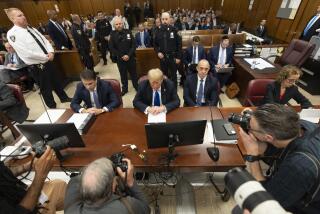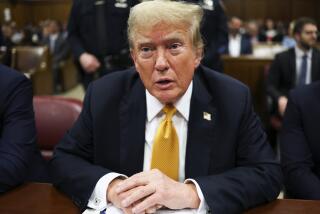At $40 a Day, They’re D.C.’s Power Elite
- Share via
WASHINGTON — They read. They doodled. They dozed.
There were times when the 23 grand jurors hearing the Monica S. Lewinsky case seemed as bored as could be with the testimony unfolding before them. They moved about the courtroom, consumed snack foods and generally allowed aides to independent counsel Kenneth W. Starr to handle the interrogation--at least according to some of the 70-odd witnesses who have come to testify before the panel during the last six months.
But do not underestimate this group of everyday residents of the District of Columbia--plucked at random from the city’s voting rolls to participate in presidential history. They also displayed moments of intense concentration and unexpected independence.
When testimony struck them as important, some scribbled furiously in notebooks. They occasionally lobbed questions of their own. And the jurors, most dressed casually, even recessed court themselves when the lawyers in the fancy suits showed no signs of adjourning.
On Monday, after hearing from scores and scores of witnesses over six long months, grand jurors Nos. 1 through 23 will find themselves on the front lines of the inquiry as they watch, albeit on closed-circuit TV, President Clinton’s testimony.
*
Although Congress will ultimately weigh the evidence, for now, the grand jury is trying to determine whether Clinton lied about a sexual relationship with Lewinsky, a former White House intern, and obstructed justice in seeking to keep the alleged relationship secret.
Far more powerful than suggested by their piddling pay of $40 a day, plus a few dollars to get to and from the courthouse, grand jurors operate behind a court-imposed veil of secrecy that keeps their identities hidden and their courtroom closed.
Only prosecutors and witnesses--and sometimes translators and stenographers--get to see them at work.
Yet the Federal Rules of Criminal Procedure do not prohibit witnesses from disclosing their closed-door experiences, even if that means grumbling that the jurors seemed a wee bit inattentive to what was going on.
“They were clearly bored,” recalled one of the witnesses to appear before them. “Their heads were down. Three walked in midway through my testimony. They were returning from the bathroom.”
Other witnesses, most of whom are in the White House camp, have seemed to try to butter up the jurors in comments to reporters.
“I thought the grand jurors were nice and the prosecutors were courteous and it was actually a good morning,” television producer and presidential friend Harry Thomason said after 90 minutes of testimony this week.
The origins of the grand jury date back to 12th century England, where they were used to check the power of the crown. The Founding Fathers enshrined them in the Bill of Rights, although many modern-day legal experts complain that too often they act like sheep during their 18-month terms, blindly following the prosecution.
*
In this case, however, other factors might make them naturally sympathetic to the target of the investigation. The panel is described as predominantly black and female--two constituencies widely supportive of Clinton--and its members come from Washington, where Democrats overwhelmingly outnumber Republicans.
The jurors convene several times a week in a windowless room on the third floor of the E. Barrett Prettyman District Courthouse, which was named after a longtime judge and is now a full-blown tourist attraction.
Television cameras catch witnesses coming and going, but the jurors have remained anonymous, partly because nobody can distinguish them from the court clerks, lawyers, janitors, food service workers, security guards, stenographers and others who keep a courthouse up and running.
Back during Watergate, Washington Post reporters Bob Woodward and Carl Bernstein knocked on grand jurors’ doors after sneaking their names out of a courthouse filing cabinet, antics that inspired the wrath of then-U.S. District Judge John J. Sirica.
In this case, Chief U.S. District Judge Norma Holloway Johnson has concluded that Starr’s camp may have improperly leaked information on the proceedings to the press. No one has accused the grand jurors, who have been on the job since before the Lewinsky case broke in January, of similar transgressions.
When they take the assignment, which is pitched to them as a weighty civic sacrifice, grand jurors raise their right hands and swear to button their lips. Unlike jurors in ordinary criminal cases, grand jurors in most cases can continue to read the morning paper, watch the evening news and live without the burdens of sequestration.
One of the jurors--in this instance, a middle-age African American woman--is anointed by the judge as forewoman and is given the power to administer oaths and sign indictments. She also is responsible for keeping track of how many jurors concur with indictments, with a minimum of a dozen ayes required.
Former Philadelphia U.S. Atty. Peter Viro, a critic of the grand jury system, typically counsels clients to direct their testimony to the prosecutor and not be taken aback if grand jurors are reading newspapers or talking among themselves during testimony. Be polite, Viro advises, even when one of the grand jurors asks the inevitable irrelevant question that seems to come from Mars.
Despite a general coziness with prosecutors, some panels have shown such remarkable degrees of independence that they have broken ties with the government and been labeled “runaway” grand juries.
Grand juries, set up to determine whether probable cause exists for an indictment, usually do not hear a balanced view of the facts.
Unlike in court, where participants can have lawyers at their side for consultation, legal counsels in the grand jury room are as unwelcome as Court TV cameras.
Clinton, however, will not have to sit alone in the chair in the center of the room like a run-of-the-mill witness. Instead, he will testify from the White House Map Room, with his legal team within whispering distance.
White House Counsel Charles F.C. Ruff argued years ago that all grand jury witnesses ought to have such representation, a stance backed by the American Bar Assn.
*
In 1977, in testimony before the House Judiciary Committee, Ruff said that the current system forces witnesses wishing to consult their attorneys to endure “the mildly absurd process of leaving the grand jury room every time.”
He said that prosecutors use the burden of leaving the room “to dissuade the witness from asserting his right to counsel.”
That is what witness Robert Weiner, spokesman for the White House Office of National Drug Control Policy, said occurred to him when he sought to consult with his attorney in the middle of his grand jury appearance in January.
When the prosecutor pressed on, deflecting Weiner’s calls for a break, it was the forewoman who finally chimed in and ordered a 10-minute hiatus.
(BEGIN TEXT OF INFOBOX / INFOGRAPHIC)
The Video Set-Up
President Clinton will testify for the grand jury Monday, by way of a video feed from the White House to the grand jury room. The testimony is to begin at 1 p.m. Washington time.
*
AT THE WHITE HOUSE
In the Map Room: Clinton will have attorneys for consultations, including private attorneys David E. Kendall and Nicole Seligman and the White House counsel, Charles F.C. Ruff.
*
THE GRAND JURY ROOM
Closed circuit TV.
The jury forewoman sits at a table with the prosecutor(s) and the stenographer who has a typing machine and a tape deck.
22 jury members sit in tiered rows.
The grand jury’s composition: 12 black women, six white women, two black men and three white men, all middle-aged or older.
The terms: Normally people who testify to federal grand juries must do so in person and without benefit of an attorney. But Clinton worked out an agreement to testify at the White House and have it beamed by closed-circuit television to grand jurors at the federal courthouse.
Note: Grand jury composition based on reports from witnesses and observers.
Sources: Times Washington Bureau, Associated Press; researched by TRICIA FORD / Los Angeles Times
More to Read
Get the L.A. Times Politics newsletter
Deeply reported insights into legislation, politics and policy from Sacramento, Washington and beyond. In your inbox twice per week.
You may occasionally receive promotional content from the Los Angeles Times.










